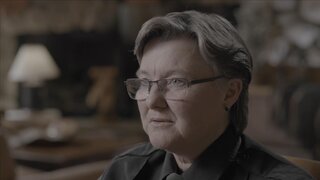A Beloved Kentucky Librarian Disappears After A Night Of Folk Dancing With Friends — What Happened?
Peggy King had recently helped a girl handle an abusive partner. Was that why she vanished?
Police received tip after tip about a beloved librarian who disappeared after a night of folk dancing with her friends. But what was the truth?
Peggy King worked in Frankfort, Kentucky as a law librarian in the state’s capital. When not there, she was an active member of the community, partaking in the local culture there in America’s bourbon belt. The close-knit city was the perfect place for close friends, the smell of distilleries in the air, and Tuesday nights saved for dancing along to southern folk melodies.
“She was one of the best dancers in the group,“ Peggy’s friend Terry Anderson told "Buried in the Backyard," airing Thursdays at 8/7c on Oxygen. “She was always smiling. She just liked people and liked life.”
On the night of Feb. 4, 1992, Peggy left her friends at the local church after their weekly get-together at around 10:00 p.m. She and her friend were the last to leave, locking up the church behind them. Colleagues and friends determined that was her last known whereabouts when she didn’t show up to work the following day. They tried calling her two adult sons, Troy and Stacey, but to no avail.
“Peggy would never just disappear,” said her friends Lizz Taylor. “She would have mentioned to somebody what she was doing.”
Friends called the police on Feb. 6, 1992. Investigators went to Peggy’s rural home, where she lived alone, and found the house tidy, showing no indication that anything was amiss. Her bed was still made as though it hadn’t been slept in. But authorities, including former lead Detective Jack Hazelwood, couldn’t ignore that her dancing shoes were at the residence, and two bowls with leftover ice cream seemed out of place on the table.
Did Peggy have company before she disappeared?
Investigators first visited her son Troy In Lexington.
“He was very worried about her,” said Det. Hazelwood’s daughter, Frankfort historian and author Rebecca Hazelwood. “But he didn’t know where she was.”
Detectives then went to see Peggy’s other son, Stacey, who was in jail on a DUI charge. He claimed he had seen his mother only a couple of days before. There was nothing unusual about their visit.
Authorities could find nothing that would signify any real problems in Peggy’s social or personal life. But then a tip was made to the Frankfort Police Department: A woman reported she was attacked on the night of Peggy’s disappearance when getting into her car at a local shopping center’s parking lot. The unknown male waited in her vehicle and tried to attack her, but the woman freed herself from the man, who fled on foot.
“It opens up a concern that there’s someone out in the community preying on females,” said Captain Dustin Bowman of the Frankfort Police Department. “Maybe Peggy was one of the victims.”
Ultimately, detectives couldn’t connect the parking lot attack with Peggy’s disappearance. But whispers in the close-knit community told of a potential houseguest who’d stayed in Peggy’s home days before she vanished. Friends led investigators to a teenager named Emily, the daughter of one of Peggy’s dance partners. Emily’s family explained that the teenager had been trying to escape a bad relationship with a man named Carlos Thurman, all while dealing with her parents’ recent divorce. Peggy opened up her home to Emily and later helped her get away from Carlos by putting her on a bus out of town.
A few days later, Peggy was nowhere to be found.
Detectives also looked into Peggy’s home life.
“Peggy never talked about problems that she was having,” Lizz Taylor told "Buried in the Backyard." “She was a very private person.”
But what police learned was that Peggy faced problems with her two sons in the wake of her husband’s passing. She was forced to kick them out of her home at one point due to rising tensions. Police also discovered Peggy had recently inherited a significant sum of money and changed her will so that the sons would get the proceeds of a trust fund at age 30, instead of the previously-stated age of 22.
Although money could sometimes be a motive for foul play, nothing connected the men to their mother’s disappearance.
One week after Peggy was last seen at the church dance, there was a break in the case when someone called to report finding Peggy’s car miles from her home. The abandoned car was towed from a remote road on the opposite side of the Kentucky River, far from where Peggy lived and worked. Forensic techs at the State Police Crime Lab later made a troubling find.
“They observed blood stains that were on the seat and the door; kind of puts the investigation into overdrive,” said Cpt. Bowman. “Our concern was definitely heightened for Ms. King’s wellbeing.”
Experts also processed fingerprints from the vehicle, as well as hairs belonging to an unknown male.
The investigation shifted back to Peggy’s houseguest, Emily, when Peggy’s friends called detectives to tell them about Emily’s ex-boyfriend, Carlos Thurman. By friends’ accounts, Thurman was a possessive man who persistently bothered Emily, even when she asked him not to contact her.
“Everywhere where Emily was, she couldn’t seem to get rid of him,” said Rebecca Hazelwood.
Cpt. Dustin Bowman said there was even a time when Thurman threatened Emily with a gun.
When questioned, Thurman said he was with friends on the night of Feb. 4, 1992. But before authorities could see if his alibi checked out, there was a major break in the case.
On Feb. 13, 1992, a local went to the city park forest to trim trees when he found a decomposing body buried in the woods. It was later determined to be missing woman Peggy King, who sustained blunt force trauma to her head and a bullet through the back of her neck.
“After we found out she was murdered, it just took the wind out of the local dance group,” said friend Terry Anderson. “She was such an integral part of it that it just wouldn’t be the same, and in a month, we disbanded. It was a very upsetting time.”
Soon after, detectives received an anonymous tip from a woman who told them they needed to speak to a man whose name was new to authorities: Demond Bush.
What struck detectives the most was that Demond Bush and Carlos Thurman were friends. Police looked into Thurman’s alibi: He was with a friend named Hope Tillman on the night of Peggy’s murder. But it didn’t take long for detectives to find out that Tillman was Demond Bush’s girlfriend.
“We now have a more clear link between Demond and Carlos,” Cpt. Bowman told "Buried in the Backyard."
Investigators canvassed the Prince Hall Village Apartments, where Thurman and Bush claimed they were on the night of Feb. 4, 1992, when a neighbor approached them with new information. The new witness claimed Bush left a gun with another resident named Sean Hunter.
Police found Sean Hunter with a gun, but it was later determined that it was not the same gun used to shoot Peggy King. Hunter was subsequently arrested for being in possession of a stolen firearm.
Investigators collected hair samples from Thurman and Bush and sent them off for forensic examination. While waiting for the results to come back, they re-canvassed the Prince Hall Village Apartments, where witnesses said they saw three men driving at the complex in Peggy’s car on the night of the murder.
“Just when you think you’re about to close [the case], you have to ask yourself, ‘Was there anybody else involved?’” said Cpt. Bowman.
A resident told authorities her brother, Sean Hunter, was with Bush and Thurman on the night of the murder. Could he have been the third person witnesses saw in Peggy’s vehicle?
During another round of questioning, detectives spoke with Carlos Thurman, who began giving details about the case he said he heard in the news. Detectives, however, knew some of the information he provided was never made public, including the two bowls of ice cream found at Peggy’s house. He also mentioned Peggy was shot through the back of her neck.
The case was circumstantial, at best, until lab results came back about the unknown hairs found in Peggy’s car: They belonged to Demond Bush.
Carlos Thurman was later arrested on a separate burglary charge. While in jail, he began discussing the murder with a cellmate. According to the inmate, Thurman said he killed a librarian because he was angry that he couldn’t find his ex, Emily.
Police believed that Thurman had the motive, while Bush had the guns. Sean Hunter was also believed to be present for Peggy King’s murder.
Thurman, Bush, and Hunter were charged with the robbery, kidnapping, and murder of Peggy King in February 1993.
Emily, who managed to stay under the radar since Peggy’s death, came forward upon the mens’ arrest. She traveled from West Virginia to Kentucky and served as a star witness in Thurman’s trial.
Prosecutors helped paint a picture of the night of Peggy’s disappearance when Peggy went home following her Tuesday dance session. Thurman met Peggy at her house where she invited him in for a bowl of ice cream.
Prosecutors believed Thurman inquired about Emily’s whereabouts, but Peggy refused to tell him where she was. They said Peggy was probably desperate to have Thurman — who was known to have violent tendencies — leave her home and agreed to take Thurman to his destination. Thurman allegedly directed Peggy to drive to the woods, where Bush and Hunter waited, standing by while Thurman murdered Peggy before helping him bury the body.
“But still, Peggy never said anything about Emily or where she was,” said Taylor.
In 1995, a Franklin County jury found Carlos Thurman guilty of murder and robbery. He was sentenced to 109 years in prison and remains at the Eastern Kentucky Correctional Complex in West Liberty.
Demond Bush’s trial came one year later. He was found guilty of first-degree robbery, kidnapping, and second-degree manslaughter and sentenced to 50 years. He was released in 2019 after serving 24 years.
For his role, Sean Hunter pleaded guilty to charges of second-degree manslaughter and was sentenced to 10 years. He was released in 2000 after serving eight years.
“Peggy King, in my eyes, saved Emily’s life,” said Cpt. Bowman. “If she hadn’t tried to help at all, I have no doubt about what would [have] happened to Emily. That’s an amazing statement about who she is and what kind of friend she was for Emily.”
The legislative library where Peggy King worked was renamed in her honor.
For more on this case and others like it, watch "Buried In The Backyard," airing Thursdays at 8/7c on Oxygen or stream episodes here.




















